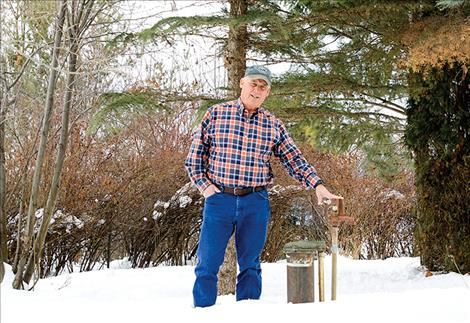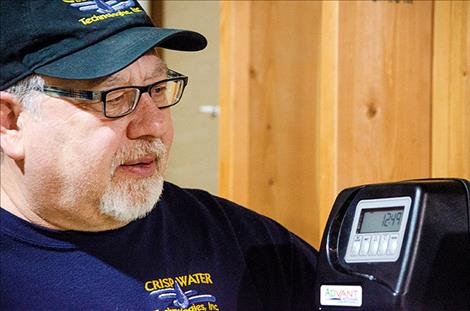Charlo residents grapple with arsenic in well water
Hey savvy news reader! Thanks for choosing local.
You are now reading
1 of 3 free articles.
CHARLO – Homeowner Tom Vaughn noticed a skin rash and unexplained problems happening around his recently purchased dream home located a few miles outside of town.
He didn’t realize those problems were connected until he got a letter in the mail from the Montana Department of Public Health and Human Services. He remembers opening the letter in December 2018 and feeling stunned. It said elevated levels of arsenic had been found in well water in Charlo. The DPHHS encouraged people in the area to have their well water tested.
According to DPHHS Public Information Officer Jon Ebelt, the DPHHS Environmental Lab tested 45 private wells among approximately 90 residents who were offered testing. “These residents were within a three-mile radius of the original well that tested high,” he said. “Eighty percent of these wells tested about the maximum containment level of 10 parts per billion.”
Certified Water Specialist Ken Crisp of Crisp Water Technologies, Inc. is working with the Montana Department of Environmental Quality’s Department of Source Water Protection and mapping the contaminated areas. Crisp said the general plume of contamination has been mapped to an area near Charlo and Moiese.
The contamination circle includes areas from Moiese to Charlo on U.S. Highway 212 and east of Charlo to I-93. “The working theory is that the contamination is centralized to this circle,” he said. More testing needs to be done to confirm the reach. He recommends that people test water wells in the Mission Valley for arsenic to be safe.
Crisp said the water tested in town had acceptable levels. The town of Charlo is on a public water system that tested at six parts per billion and is considered safe to drink at this time.
The Agency for Toxic Substances and Disease Registry notes that arsenic is a naturally occurring element. It is considered a metalloid in that it has properties of metal and nonmetal. Most arsenic compounds are white or colorless powders that don’t evaporate. “You usually cannot tell if arsenic is present in food, water or air,” the report states.
Arsenic becomes a problem when people or animals are exposed to high levels. The US Environmental Protection Agency set the drinking water standard for arsenic at 10 parts per billion, which is also read as 0.010 mg/L.
Crisp shared information from the Oregon Health Authority’s Public Health Division explaining that when water flows through certain rock formations, the arsenic can dissolve and be carried into underground aquifers, streams or rivers that may be drinking water sources.
The document states that water below 10 ppb can be used for drinking, cooking and other domestic uses. Water between 10 and 34 ppb is not recommended for drinking for humans or pets. At 100 to 499 ppb, the water shouldn’t be used for irrigating gardens as arsenic may build up in soil overtime and be taken up into vegetables.
Crisp evaluated the presence of arsenic in the area. He concluded that earthquakes could have disturbed the sediments deep in the ground about 300 to 500 feet in the areas outside of town where arsenic is testing at high levels.
“People weren’t reporting these symptoms in the past,” he said. “I think this is an acute problem that may not have always been here. There were no signs of it in people before.”
Vaughn started doing his research after he finished reading the letter about arsenic contamination in the area. He was worried. He hadn’t been drinking the water, preferring bottled water, but his wife was drinking it. Vaughn said drinking the water wasn’t the only way to get arsenic exposure. He believes the skin irritation he experienced was from showering in water with high arsenic levels. He also found out that the problem could impact his dogs. They were experiencing what he called loose stools.
He learned that arsenic has to be filtered out of the water to get rid of it. It can’t be boiled away. He contacted Crisp and asked him to come out and evaluate the problem. A sample of the well water was collected and sent to a testing laboratory. Crisp said Mission Mountain Laboratories in Ravalli has a testing kit for $14. Test kits can range in price, depending on how detailed they get and the company used. Crisp said the Confederated Salish and Kootenai Tribes were providing free tests along with the DPHHS for people in the contaminated area. The DPHHS free testing deadline was on March 15. When Vaughn’s test results came back, Crisp said he was shocked.
“I’ve been a water specialist in Western Montana for 27 years, and I’ve never seen numbers this high,” he said. Crisp said Vaughn’s test results showed that the arsenic level in his well water was at .135 per liter. “That number is very high and toxic,” he said.
The next step was to put a filtration system on the water coming into the house. The system needed to be big enough to handle all the water, not just drinking water. Crisp installs filtrations systems called AdVantEdge. One of the systems is a Medallion Advantage arsenic treatment system by AdEdge Water Technologies, LLC.
He said the arsenic was so high in Vaughn’s home that he needed a two-tank system that uses a special filter media.
The tanks are about four-feet tall with an initial cost of about $3,000 for a single system. The filtration material needs to be replaced about every three years with a cost of about $600 per tank. Other companies are also installing systems in the area.
“Even though the treatment systems can be pricey, the alternative could be severe health issues including kidney and liver damage, hair loss, and eventually toxicity to the point of possible death,” Crisp said.
Vaughn isn’t sure how long he will need his filtration system. Crisp said the arsenic could “flush through” or it could be in the area for a long time. “Continual testing is the only way to protect yourself,” Crisp said.
After Vaughn’s system was installed, he was still cautious. He waited until another test showed that the water was clean after it was filtered. Crisp said caution is important: “This is a serious health concern. People need to contact a certified specialist to help them take care of this problem. Don’t mess around with your health and water, especially in an area with high arsenic.”
Lake County MSU Extension Office agent Jack Stivers said the arsenic levels in the water could impact livestock and other animals. He said symptoms might not show up right away because arsenic accumulates in the system over time. The symptoms in cows could include lethargy, hair loss, stomach inflammation, watery fecal matter, dehydration, reduced milk production and even death.
The Extension Office distributes well testing kits with the cost associated with the type analysis requested. He recommends filtration systems for well water in areas with high arsenic levels for humans and animals.



















